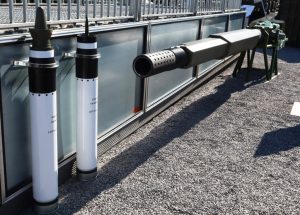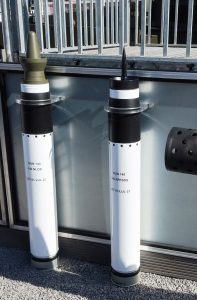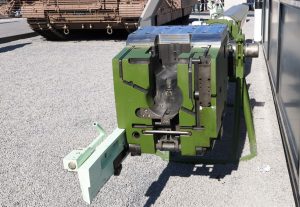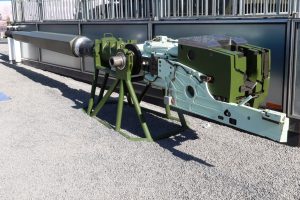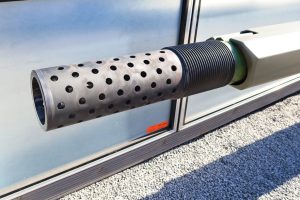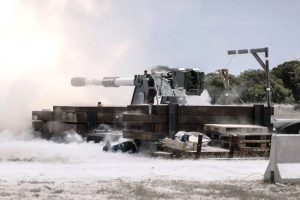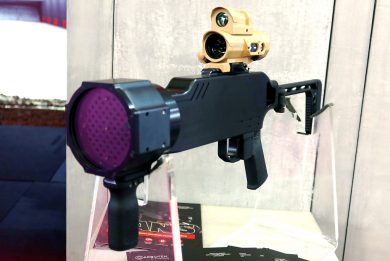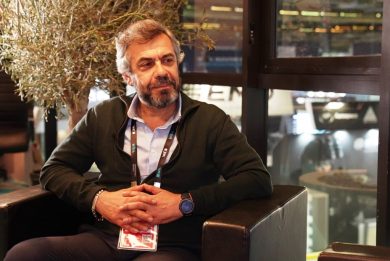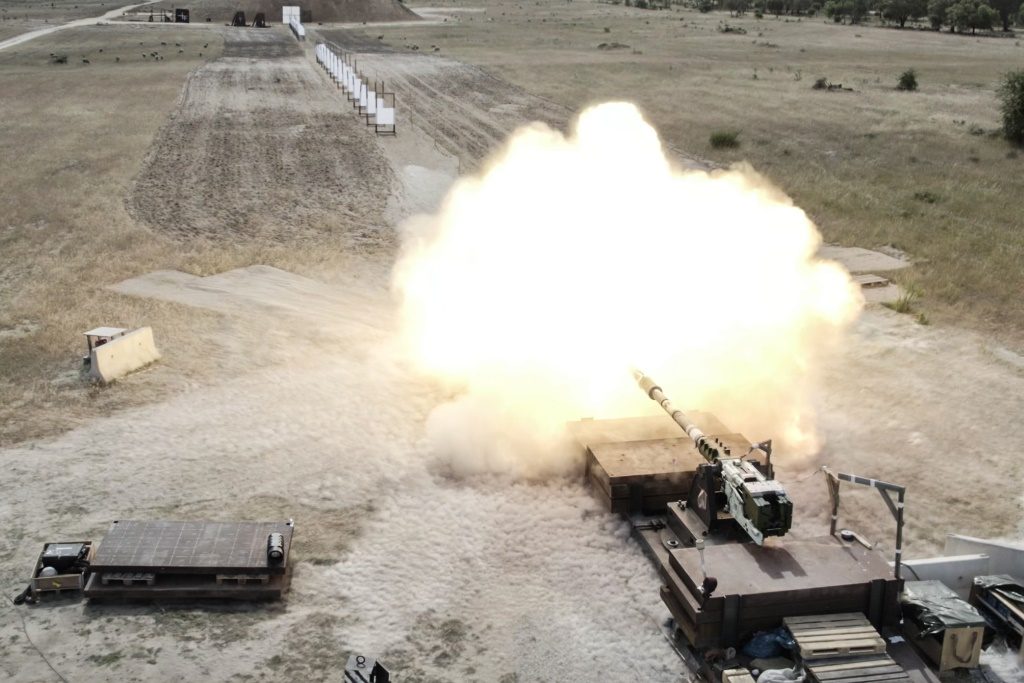
Ascalon: Nexter’s solution for the MGCS main gun
Both contenders for the future western main battle tank gun calibre were present at Eurosatory 2022 the bigger one, 140 mm, being visible on the KNDS stand.
Developed by Nexter it is known as ASCALON, which stands for Autoloaded and SCAlabLe Outperforming guN, and has been under development for some time, the French company having unveiled its project in spring 2021.
The Paris exhibition was however the first public appearance of the Ascalon system, which is made of the gun and the ammunition, in a major international exhibition, although the prototype seen at Villepinte was not the latest iteration.
“We went for a 140 mm weapon in order to leverage part of the work done in the 1990s when we took part in the Future Tank Main Armament programme, FTMA in short, which generated a number of prototype guns in that calibre,” Dominique Bouchaud, the Ascalon programme manager explains.
“On the other hand we didn’t have precise requirements from potential users. Currently the Main Ground Combat System programme office issued only High Level Requirements, and what we could understand is that as we are considering levels of protection in the 2040s and beyond, one of the needs is to have a considerable growth potential to be able to answer future evolutions,” he adds.
Some European nations consider the T-14 Armata as the benchmark in terms of protection, and EDR On-Line felt a certain confidence in terms of knowledge on that MBT armour from more than one western manufacturer. How much the T-14 will evolve before and if it will move to mass production remains to be seen. On the other hand another high-level requirement seems to be an increased range. “However the line-of-sight visibility range on the battlefield rarely exceeds the 1,500-2,000 meters, so the 5,000 meters range will have to be reached with Beyond-Line-Of-Sight rounds, therefore the new gun will have to be capable to fire BLOS ammunition that will be developed,” Mr. Bouchaud says. What seems certain is that the future manned element of the MGCS programme will still have a main direct fire weapon, the gun, although this might not be the only weapon available on board. As some put it, “the tank might evolve as the navies flagship did, switching from battleship to aircraft carriers, which give a much higher flexibility.”
As said initially two of the companies involved in the MGCS programme are proposing guns in two different calibres, both developed with internal funds, Rheinmetall of Germany having unveiled its gun in 2016. “We adopted a completely different philosophy in the development of our 140 mm gun. First of all compared to the FTMA, which round was 1.5 meters long, the new APFSDS round is 1.3 meters long and weighs around 30-35 kg,” Dominique Bouchaud tells EDR On-Line; for comparison a 120 mm APFSDS round is 984 mm long and weighs around 20 kg. Nexter starts from a vantage point, as the Leclerc MBT, developed by then GIAT Industries, is armed with a 120 mm smoothbore gun fitted with an automatic ammunition loader, a system that will definitely be part of the future tank considering ammunition dimensions and weight.
“The other main difference is that we decided to maintain the chamber pressure at a reasonable level, in fact currently the peak pressure is lower than that of the 120 mm gun. To ensure we get the right energy to provide the necessary muzzle velocity to the round we increased the chamber volume, which is 2.5 times that of the current Leclerc gun,” the programme manager explains. When using an APFSDS (Armour Piercing Fin Stabilised Discarding Sabot) round the terminal effect against the enemy tanks is due to the kinetic energy transferred to the target. “We have a muzzle energy of 17-20 MJ, considering both the penetrator and the sabot, that of the sabot being of course useless in terms of terminal effect. During its flight the penetrator loses between 12 and 16% of the initial energy, so in the end what gets to the tank armour that must be defeated is around 7-8 MJ,” he continues, while a 120 mm KE round goes from 12 MJ to 6 MJ on the target. The 140 mm energy on target is sufficient to defeat in service MBTs, such as the T-90M, as well as the T-14, but it is at the limit for penetrating the frontal arc armour, considering the reduced angle of impact due to the glacis inclination.
The Ascalon has however a considerable growth potential in terms of pressure increase, which would allow a higher muzzle velocity hence a greater kinetic energy on target, which is reached after a flight of around 1.5 seconds, the time needed to cover the 2 km trajectory. Increasing speed means however increasing drag, this being proportional to velocity square, hence the need for improved aerodynamics for penetrators. “We currently have penetrators with an aspect ratio, diameter over length, of 30-35. We are exploring the behaviour of rods with a much higher aspect ratio, which should allow maintaining a higher energy up to the target,” Dominique Bouchaud says. Longer rods with a higher aspect ration must be carefully studied in terms of internal and external ballistics, as vibration inside the barrel as well as in flight is a key issue to ensure the required accuracy, which has to be even greater than that obtained with current 120 mm rounds, as longer ranges are part of the requirements. The projectile mass is the other variable that influences the kinetic energy delivered on the target; France, as well as other European countries, do not consider depleted uranium that by the way provides only a marginal increment, less than 6%, over tungsten.
The 140 mm gun currently being produced will have a mass of around 3,000 kg, and breech to muzzle it will be 7.3 meters long, with a 51-52 calibres long barrel. That shown at Eurosatory was a hybrid version that included many elements of the old FTMA gun, which were far from being optimised for weight. It is fitted with a pepperpot recoil brake/flash hider, although one of different design can be seen during some firings. In fact numerous recoil brake configurations were tested, and finally, according to Nexter, the pepperpot proved to be sufficient to reduce the recoil at the desired level. Nexter has been working on rigidity, in order to control oscillating modes and frequencies, as well as on balancing. The result will be a weapon lighter than the current 120 mm L55, which mass is around 4,100 kg. The new gun will be ready in early 2023, Nexter having worked in close cooperation with system and turret specialists in order to make sure that its 140 mm gun can be integrated into a tank with a combat mass of 55-60 tonnes, the target mass for the MGCS MBT being 55 tonnes. It is of course compatible by design with an autoloading system.
Awaiting the new gun, Nexter has carried out a number of firing campaigns with the existing gun, one that ended just before the Paris exhibition, while another one should take place before year end. The second phase of the programme should capitalise on the results of those previous firings, to develop a holistic study taking in count all parameters in order to optimise the concept for the future MGCS.
No indication on barrel wear are of course available yet, although Nexter underlines that this depends very much on the type of ammunition used, APFSDS rounds having a higher muzzle velocity tend to wear the barrel more than full bore rounds. The lack of precise requirements doesn’t allow the manufacturer to freeze some parameters; one of those is maximum elevation, on which a discussion with potential customers is ongoing, and which has an impact on indirect (BLOS) fire missions and range. “If they will ask us an 8 km range this is feasible, of course if they ask for a 15-20 km range this has an impact on elevation, and would rule out a remotely operated solution,” Dominique Bouchaud underlines.
The Leclerc automatic loader can host 22 ready rounds, 18 more being available in the chassis; due to the bigger calibre the autoloader of the 140 mm gun will probably host some rounds less, therefore the ammunition mix has to be considered carefully. For long range indirect fire missions missiles could be a solution, and moreover considering the new tank within the MGCS, let’s not forget that the last “S” stands for “System”, some roles might be assigned to accompanying armoured vehicles, manned or unmanned, the MBT being the core of the system.
“We should soon start talks with Rheinmetall, putting on the table our respective solutions, considering the plus and minus, and coming to a final solution that might even be a different calibre compared to those proposed and developed until now,” the Ascalon programme manager explains. Another question mark lies over the Atlantic, as it is unclear which path the US Army wants to follow. Imposing a new standard might be quite risky, therefore cooperation seems the best solution, although this might generate further delays, and the MGCS programme is all but on time, the 2035 Initial Operational Capability being a sort of dream. All in all, should everything go well, France and Germany might have an initial requirement for around 500 tanks, a relatively small number to impose a new ammunition standard. The fact that among the design features Ascalon is compatible with current tank fleet might help; tank upgrades might be feasible, eventually replacing the whole turret while maintaining current mobility platforms, reducing acquisition as well as logistic costs.
Many devil’s advocates consider the war in Ukraine the demonstration that tanks are dead; first of all let’s say that no evidence of the damages caused by tanks have ever been publicised, while the defeat of MBTs, of older generation has been widely advertised. Tactics, logistics, training, motivation, are all links of a chain in which the technical element is just one of the key factors. Looking at Eurosatory it was quite evident that the de profundis for MBTs has still to be played. The way ahead for a European solution is definitely not simple, and how much the thrust towards heavy armoured vehicles that might come from the current conflict will bring the different parties towards mutually shared solutions has to be seen.
Photos by Nexter and P. Valpolini

